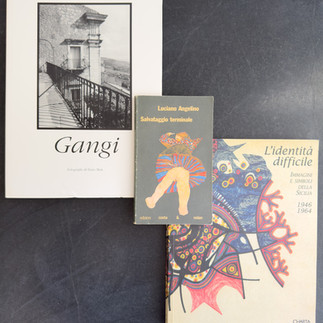Design Notes from my Trip to Italy
- Christine Oh
- Jun 15, 2024
- 7 min read
My husband and I had the opportunity to travel to Italy back in October for a wedding, and I am abysmally late in writing about our travels. But write I will because I came back feeling inspired by many things we saw during our stays in Rome, Florence, and Sicily. Following are my design notes from our trip.
Italian interior design
When I travel, I love finding unique and beautiful places to stay. For this vacation, that included two Airbnbs and one boutique hotel. All were distinctly different in style, but each had design details I loved.
The barrel ceilings of the former palazzo we stayed at in Palermo served as a good reminder that sometimes a simple architectural choice can make a huge impact on elevating the look and feel of a room without the addition of decorative molding. I also fell in love with how our host designed the space, mixing both organic and modern elements to achieve what I can only describe as a quintessentially Sicilian home.
In contrast, the style of our accommodations in Rome were very different. We stayed at Relais Donna Lucrezia, a boutique hotel near the Villa Medici and Villa Borghese museums. The hotel recently underwent renovations, resulting in a refreshed and charming space.
In Florence, we bravely walked four flights of steep stairs multiple times a day for our Airbnb stay, but it was well worth the exercise to have a top floor space with tons of natural light. The weather in October was lovely enough to leave the windows open all day and night, which provided excellent air flow throughout the home...a feature of older buildings that modern design has sadly lost.
Italian Antiques: Books & Lighting
One thing to know about me is that I love antiques. The internet and social media are obsessed with French broccantes – but what about the antique markets everywhere else in Europe? During our trip, we stumbled across a few Italian antique mercatos that we explored. In Italian, “mercato delle pulci” means flea market, and they are everywhere.
I wasn’t interested in checking any bags this trip, so I looked for items that would easily fit in my carry on. I found a few vintage Italian books at a second-hand bookshop in Palermo, two of which are all about Sicily and a third featuring some eye-catching cover art. I love looking for vintage books because they are great for styling surfaces around my home. In Florence, I also found an antique wall sconce that, once rewired and styled with a new glass shade, will be ready to adorn a wall once again.
Center: Il Mercato Storico Antiquario Delle Pulci in Florence
"Unconfined" Art & Romantic Landscapes
Italy, as the epicenter of the Renaissance, is famous for its rich art history. However, it wasn't the art in the museum that gave me design inspiration for wall hangings on this trip.
A drawing of a lizard in our Palermo Airbnb drew my attention. Aside from the fact that he reminds me of the lizards that run around our yard in Florida, I love that he was drawn using a pointillism technique and that his tail, rather than being cut off my the photo matte, was actually drawn onto it. I love the idea that simple, framed art can be unconfined by the borders that surround it. Is this a profound, revolutionary idea? Absolutely not. But it's a small, quirky and fun framing trend.
I was also inspired by some of the photos I took on our trip (with my iPhone, if you can believe it). I snapped the below image of Sicily's L'Arenella Beach during a sunset sailing trip we took up the coast on an antique 1968 wooden sailboat. I think this landscape photo would look stunning scaled larger and framed in an acrylic shadow box. Although, I'll have to wait on tackling that idea in real life considering the cost of that type of framing!

Mosaics
Mosaics are having a resurgence currently in design, although I'm not sure modern methods can replicate the beauty of historic originals. You can find mosaics all over Europe, but some of the ones we saw in Italy were divine.
The colorful and dense mosaics shown in the first image below are from the Chapel of the Madonna di Trapani, located in the Chiesa di San Giuseppe dei Padri Teatini in Palermo. The church is a prime example of Sicilian Baroque design and was constructed at the beginning of the 17th century. The mosaics in the chapel were expertly crafted primarily of colorful marbles and a variety of semi-precious stones, the design of which I think could look beautiful today reinterpreted as a wallpaper.
The image on the right depicts the mosaic floors from the Battistero di San Giovanni in Florence. While the uniquely octagonal, Catholic baptistery as it exists today was built in c. 1059, the marble inlay floors were laid in c. 1209. Their design, which is incredibly modern looking by today's standards, represents a blending of ancient geometric and Islamic-inspired patterns. Fun fact: Sicily has deep Islamic roots dating from the 9th century when it was formerly an Islamic emirate — and, that rich history has left a lasting impression on the design, architecture, and culture of many cities throughout Italy.
From left: Chapel of the Madonna di Trapani in Chiesa di San Giuseppe dei Padri Teatini in Palermo, Sicily; Battistero di San Giovanni in Florence
Exterior Design Elements
Everything about Italian buildings is aesthetically lovely and you can gain lots of inspiration just from exploring on foot. Four thoughts from my walks around the cities we visited:
Colored roof tiles: It occurred to me when touring the tops of different churches around Italy that roofs used to be designed with both practical and aesthetic purposes in mind. Somewhere throughout time we lost the latter element of design. Take a look at the simplicity of the roof tiles of the Palermo Cathedral below for instance: they are scalloped and laid in alternating rows of green and what looks like a faded terracotta. My home in Florida has the standard terracotta roof, which I do like the look of...but, imagine if a similar color scheme could be applied...
Historic doors: I took way too many photos of old doors during our trip. The older, the better! They ultimately reminded me of how much I dislike the design of most modern doors, especially builder grade ones. Exterior doors in Florida really should be impact-rated for hurricanes, making it unrealistic to use actual antique doors...BUT, surely there are companies that can reproduce historic door designs with modern engineering features? If you know of a business that does this, let me know!
Organic window boxes: I'm honestly not sure if "organic window boxes" are really a thing, but I'm obsessed with the way that the red and white flowers are spilling out of the window pictured below. If you look really closely, you can see a small, natural fiber hanging pot of some sort that they are planted in, which I assume is attached somehow to the window grill. And, it looks like they've attached small trellis' to the sides of the window to encourage the plant to continue spreading across the building's facade. However they've designed it, it's a cool take on traditional flower boxes.
Timeless signage: Modern street signs are ugly, this is a fact. I love these minimalistic Italian street signs, carved in stone and attached with miniature fleur-de-lis hardware. This style is probably not fit for actual US street signs, but it's good inspiration for numbering a home, labeling streets in a master plan community, or something else.
From left: Roof of the Palermo Cathedral; the door of 17 Via Santa Reparata in Florence, Italy
From left: the door of Osteria e Vinaino Cicalone that opens on to Via del Moro in Florence; street signs for Via del Canto dei Nelli in Florence
Textiles
As both a cultural Mecca during antiquity and the birthplace of the Renaissance, Italy houses an incredible amount of art, all of it breathtakingly beautiful.
Among the awe inspiring artworks, I gravitated most toward the religious pieces. As someone with an appreciation for design, I am drawn by the beauty in how biblical stories are depicted. What really blows my mind though is how modern the patterns look, despite being painted nearly 600 years ago. For instance, the patterns from the 1950s feel reminiscent of the Madonna's blue robes below, while brocades that have spanned centuries can be mapped to the orange swaddle of the infant Christ on the right. Whatever your personal feelings may be about religious works, these are stunning examples of how some design is simply timeless.
From left: Madonna con Bambino e due donatori, Annunciazione e santi (1360s) by Jacopo di Cione, Galleria dell'Accademia; Saint Michael the Archangel (1360s) by Matteo di Pacino, Galleria dell'Accademia; Madonna col Bambino in trono e due angeli musicanti (1353-1358) by Andrea di Cione detto Orcagna, Galleria dell'Accademia
Archaeological Objects
Continuing with the theme of historical inspiration, I also saw some decorative objects at various museums and churches that I absolutely fell in love with. As in, I wish the gift shops had sold exact replicas of these items because I would have bought them.
Below to the left is an ivory pyxis (a small cylindrical box for storing small items) made in an Islamic-Sicilian style, displayed in the Palermo Cathedral; to the right is an Etruscan bucchero (meaning shiny, black ceramic) two-handled vessel, likely made in the 6th century BC, which we saw at the Palermo Archeological Museum.
When I see cool items like these, my first thought is always, "Wow, I wish I could buy these somewhere." Sadly, of course, no one I know of makes stuff like this. If I were to ever get into manufacturing, I would want to get into high quality reproductions of historic objects or produce versions redesigned with a modern lens.
From left: 12th century Byzantine-era ivory pyxis, Palermo Cathedral; 6th century Etruscan bucchero two-handled vessel, Palermo Archeological Museum
This was my second trip to Italy, and I hope to get back again soon for more design inspiration because it is easily one of my favorite countries I've visited so far in Europe. Up next for 2024 though are Ireland and Mexico, so stay tuned for my design notes from those countries at some point this year!
Happy nesting <3
Christine
.png)

























































Comments